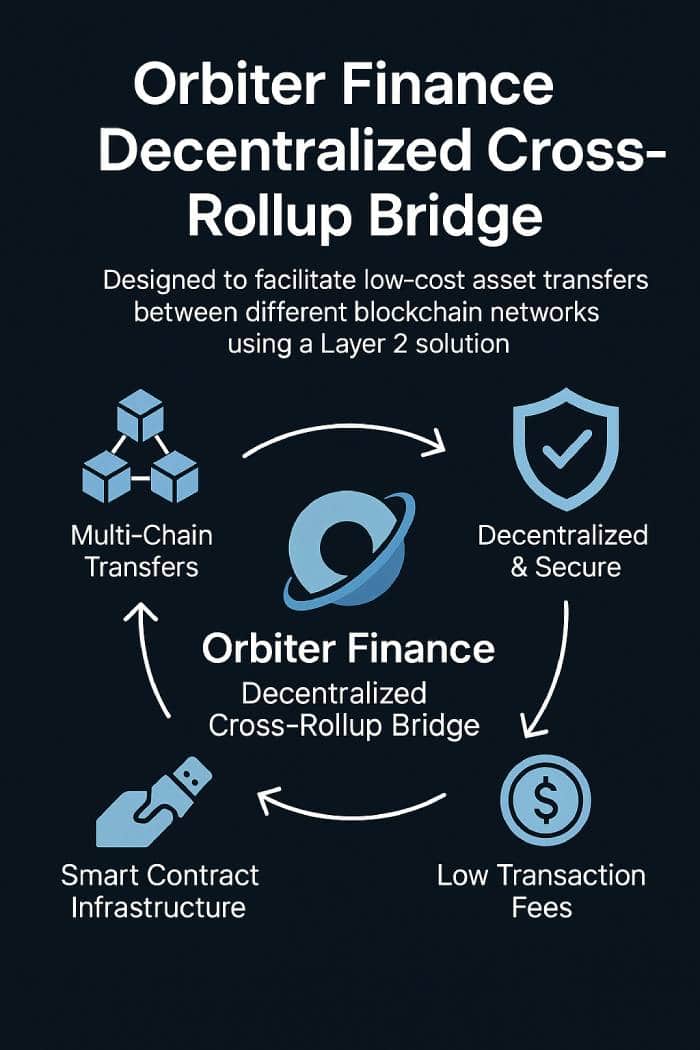Orbiter Finance: Your DeFi Guide

Orbiter Finance is a decentralized cross-rollup bridge designed to provide seamless interoperability across the Ethereum ecosystem. By utilizing advanced ZK technology and smart contract infrastructure, this protocol facilitates secure, low-cost, and near-instant asset transfers between Layer 2 rollups like Optimism, Linea, Base, Scroll, Starknet, Arbitrum, and Polygon.
The platform is engineered to enhance the efficiency of decentralized applications (dApps) and digital asset transfers, enabling smooth movement of crypto across multiple chains. Orbiter Finance supports 13 blockchain networks and aims to evolve into a full-scale multi-rollup infrastructure—an omni-connected solution for Layer 2 scalability.
What is Orbiter Finance?
Orbiter Finance is a decentralized protocol designed to facilitate seamless asset transfers between different blockchain networks. Built for the decentralized finance (DeFi) era, it enables secure, cost-effective movement of crypto by using a unique mechanism based on the Sender-Maker model and smart contract automation.
Orbiter Finance provides multi-chain support across platforms like StarkNet, zkSync, Polygon, and Arbitrum. By eliminating traditional cross-layer 1 vulnerabilities, it ensures a safer and more efficient transaction experience for users.
Multi-Chain Asset Transfers
The Orbiter bridge supports asset transfers between different blockchain networks, enabling users to connect and interact with diverse ecosystems. This enhances overall accessibility and makes decentralized applications more flexible across blockchains.
Low-Cost Chain Transactions
The protocol is specifically designed to minimize transaction costs. Its optimized bridging mechanism ensures that users can transfer assets without incurring high fees, making the service accessible and efficient for everyday use.
Decentralized by Design
Orbiter Finance is built on decentralized infrastructure, relying on smart contracts and trustless interactions to maintain security and transparency. No additional tokens are needed for liquidity, reinforcing the platform’s commitment to decentralization and user trust.
The platform also features a real-time dashboard tracking Layer 2 activity, performance metrics, and popular DeFi applications.

What are Crypto Blockchain Bridges?
Crypto bridges allow users to move assets across different chains or Layer 2 solutions. For example, someone holding funds on Ethereum may wish to transfer to StarkNet for lower fees and faster transactions.
Orbiter Finance provides a fast, secure, and user-friendly bridge to StarkNet and 12 other networks, including Arbitrum, zkSync, and Polygon.
- Secure: Mitigates risks common in cross-layer 1 bridges.
- Instant & Low-Fee: Leveraging Sender and Maker wallets for near-instant transactions.
- Decentralized: No native token needed for liquidity provisioning.
In addition to transfers, the platform offers valuable insights into blockchain performance via its analytics tools.
How to Bridge Crypto with Orbiter Finance
Using Orbiter Finance to transfer assets is simple. To bridge crypto to StarkNet using Argent X, follow these steps:
- Open Argent X and select "Add Funds."
- Choose "Bridge from Ethereum and other chains."
- Select "Orbiter Finance."
- Connect your Ethereum wallet and your StarkNet-compatible wallet.
- Enter the amount, approve the transaction, and receive funds in minutes.
If using zkSync, switch to Argent mobile. MetaMask works for other EVM-compatible chains.
How the Protocol Works
Orbiter Finance uses a dual-role system:
- Sender: Initiates asset transfers from the source chain.
- Maker: Holds reserve liquidity and releases equivalent value on the target network.
Makers deposit margin in advance, earning income with each successful transaction. This mechanism ensures that funds are available instantly and minimizes risk for both parties.
Additionally, Orbiter utilizes zero-knowledge proofs (ZK-proofs) to validate asset transfers across chains without exposing sensitive data:
- Users initiate transfers via smart contracts.
- Assets are locked securely.
- ZK-proofs validate the transaction.
- Tokens are released on the destination chain.
- Users confirm ownership to claim assets.
This ensures Orbiter Finance delivers secure, scalable, and private cross-rollup interoperability.
Advantages and Challenges
Pros:
- Unique decentralized cross-rollup bridge design
- Efficient, low-cost asset transfer solution
- Strong community presence and growth
- Over 700,000 users and 35M+ transactions
Cons:
- Limited clarity on tokenomics
- Lack of extensive audit reports
- Modest investment visibility
- Marketing and SEO underperformance
- Limited transparency on core team
Addressing these areas through audits, clearer communication, and stronger partnerships could boost platform credibility.
Understanding Decentralized Cross-Rollup Bridges
Decentralized cross-rollup bridges like Orbiter Finance are essential for improving blockchain scalability. They allow for smooth interoperability between Layer 2 solutions on Ethereum, reducing network congestion and transaction fees.
By processing transactions off-chain and settling them on the Ethereum mainnet, rollups boost efficiency. Orbiter connects these rollups, enabling asset transfers across the ecosystem in a secure and low-cost manner.
This infrastructure allows users to explore and interact with DeFi applications on multiple chains, enhancing the utility and accessibility of decentralized finance.
Orbiter Finance Airdrop and $OBT Token Launch
Orbiter Finance is preparing to launch its native token, $OBT, alongside a comprehensive airdrop campaign aimed at rewarding early supporters and active community members. This move is designed to enhance token accessibility, decentralize ownership, and stimulate engagement across the network.
What Is the $OBT Airdrop?
The $OBT airdrop is part of Orbiter Finance’s strategy to distribute its native token in a decentralized and fair manner. Eligible users can receive rewards based on past activity, platform contributions, and NFT ownership. The airdrop also promotes the use of Orbiter’s cross-rollup bridge for low-fee asset transfers.
Key Dates to Know:
- Snapshot Date: January 16, 2025 — used to assess eligibility across supported blockchains
- Token Generation Event (TGE) and Listing Date: January 20, 2025 — $OBT will be listed on exchanges like KuCoin, Gate.io, and Bitget
- Claim Phases: Users can claim in stages beginning on January 20, with additional rounds on January 23 and 25
Who’s Eligible for the Airdrop?
To qualify, users must meet one or more of the following conditions:
- Active participation since December 2021, with at least 2 months of usage
- Holders of Ace Pilot or Expert Pilot NFTs
- Accumulation of 40+ O-Points through platform activity
- Involvement in community events, Discord moderation, or verified event attendance
Participation requires prior engagement but is free of charge for qualifying users, with rewards provided directly to their connected crypto wallet.
How to Claim $OBT Tokens:
- Visit the official airdrop portal: orbiter.finance/airdrop
- Connect your wallet using "EVM Connect"
- Authorize the connection and check your eligibility status
- If eligible, click "Claim" and confirm the on-chain transaction
Using Orbiter Finance to transfer assets between Ethereum and Layer 2 solutions like Arbitrum or zkSync also increases your visibility for future airdrop campaigns within the ecosystem.
Withdrawing and Trading $OBT
Once claimed, users can transfer $OBT to their preferred exchange. The token will be available for trade starting January 20, 2025, with more listings expected. $OBT is positioned as a utility token within the Orbiter ecosystem, powering liquidity incentives and user rewards.
Airdrop Checker Tool
To verify eligibility, Orbiter provides a live airdrop checker:
- Go to the OBT Airdrop Checker on the Orbiter platform
- Connect your wallet
- View your claim status and any pending rewards
Earning O-Points for Future Rewards
O-Points are loyalty metrics tied to user activity. Here's how to earn them:
- Use the Orbiter bridge for regular asset transfers
- Complete platform quests and missions
- Participate in campaigns or events hosted by the community
Accumulated points may determine eligibility for future airdrops or staking rewards.
2025 Roadmap for the Orbiter Ecosystem
Orbiter Finance plans to grow its infrastructure and community through:
- Q1: Rollout of decentralized staking and a dynamic incentives interface
- Q2: Broadening cross-chain support and wallet integrations
- Q3: Improving visibility and introducing additional DeFi tools
The roadmap emphasizes building a robust, decentralized product suite powered by the $OBT token.
$OBT Token Price Forecast
Analysts expect that the $OBT token will gain strong traction shortly after launch:
- Short-term (1–3 months): $0.5 – $0.8 depending on market momentum
- Mid-term (3–6 months): Up to $1.2 based on ecosystem growth
- Long-term (12+ months): Potential to exceed $1.5 if adoption and liquidity scale
Note: Price predictions are speculative and influenced by broader market trends.
Final Thoughts
The Orbiter Finance airdrop is more than a promotional event—it's a strategic effort to reward participation, increase decentralized ownership, and activate liquidity within the protocol. By claiming and using $OBT, users become part of a growing Layer 2 ecosystem designed to support secure, efficient, and scalable asset transfers between blockchains.
Disclaimer
This guide is for informational purposes only and does not constitute investment advice. Engaging in token claims, crypto transactions, or DeFi services involves risk. Users should always conduct independent research and use official channels to avoid scams. Your wallet security and informed decision-making are essential when navigating the blockchain space.




